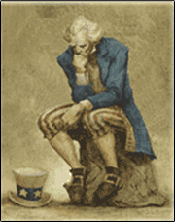Whither the National Endowment for the Arts?
Once again, the question of whether to eliminate the National Endowment for the Arts and its claim to federal funding is on the table. For communities enjoying an abundance of writers and artists, readers and patrons, the prospect of the NEA’s possible demise may provoke heartburn and discomfort.
Federal budget patronage of the arts is a 20th-century construct. In 1935, FDR’s New Deal funded the Federal Art Project through the Works Progress Administration. It was a broad-spectrum outreach supporting as many as 10,000 writers and artists, focusing on paintings, graphic art, murals, sculpture, art education, and documentaries.
WPA-commissioned or supported murals appeared in numbers in railroad stations, federal institutional buildings, and US Post Offices. They won broad public support, with many surviving today. Arguably, the most influential painter, watercolorist, muralist, and screen printer was Thomas Hart Benton, whom the Federal Art Project commissioned for numerous undertakings. His advocacy and influence over the Federal Art Project overall were equally formidable.

“Raising the Bear Flag,” by Anton Refreiger, painted in the early 1940s for San Francisco’s Rincon Center Post Office. Public domain.
While Benton was established well before 1935, the WPA helped start other well-known artists’ careers. Benton’s student Jackson Pollack—the antithesis of Benton—benefited enormously from the WPA.
Perhaps the most striking documentary photo gallery book from that era was 1941’s Now Let Us Praise Famous Men. It wasn’t a WPA production, for Fortune magazine underwrote it. Nonetheless, the two men who created it, writer James Agee and photographer Walker Evans, were earlier direct grant recipients from the WPA .
Before the New Deal, the arts received no federal stipends of any kind. Thomas Cole and Frederic Church of the Hudson River School aesthetic landscape movement never received a dime from the federal government. Neither did the likes of Frederick Remington, George Caleb Bingham, Emmanuel Leutze, and John Singleton Copley.
Did Walt Whitman, Herman Melville, Mark Twain, or William Falkner receive a grant from the federal government? Uh…no.
So, let’s fast-forward to the NEA today. Since 1965, has the NEA produced anything approaching the scale of the government-funded WPA artists, even far less than the private patronage and good fortune sprinkled on all writers and artists before the New Deal?
The only notable NEA production has been the performance art of Karen Finley, a multiple NEA grant recipient. Here is Richard Bledsoe, editor of Remodern Art Review:
Her claim to fame was hooting obscenities while smearing her naked body with yams. I wish this was a joke or an exaggeration, but it isn’t. Of course it was all about gender roles and social critique and whatnot, so that made it Serious Art.
When the NEA produces a Caravaggio, or any of the Dutch Masters, sign me up.
Until then, no. Whither the National Endowment for the Arts? Its dispatch into the netherworld cannot happen fast enough.





